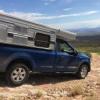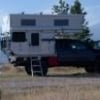After looking at several models' instruction manuals, it seems that for a >10ft run for a 30Amp system, 6-8AWG is recommended. Is it dangerous to use 10AWG or are you just forfeiting some efficiency, not running the risk of overheating, damage, fire, etc.?

4AWG from the factory?
#11

Posted 12 November 2020 - 06:24 AM
2014 F-350 | 2019 FWC Hawk | King Suspension
#12

Posted 12 November 2020 - 08:19 AM
10' on which side, input or output? Either way, there is inherent inefficiency with running thinner wire. No risk with 10g as it can easily carry 30A, as rando noted above. On the output side, the inefficiency matters more, but likely not much. I would run the fattest wire that fits into the terminals on the device on the output side.
2012 ATC Puma Shell build - https://www.wanderth...012-puma-build/
Power considerations thread - https://www.wanderth...e-power-scotty/
Building out an electrical system - So, you want to setup a good electrical system in your camper? - Electrical, Charging, Solar, Batteries and Generators - Wander the West
#13

Posted 12 November 2020 - 02:49 PM
It is not a safety issue - as mentioned previously 10AWG is rated up to 60A, so no issue there. You do want the wires on the output of the DC-DC to be short and/or fat so that the battery being charged is seeing close to the same voltage as the charger is providing.
Assuming a 15' round trip from the engine bay to the camper, you will have about a 6% voltage drop. This doesn't change the rate of charging, but means the alternator will need to provide 6% more power - not really noticeable in the grand scheme of things.
Assuming you are considering a Victron DC_DC, then the only possible issue I can see would be tuning the 'engine on detection parameters' to work with your alternator and the voltage drop in the wires. You may need to adjust these from the default.
After looking at several models' instruction manuals, it seems that for a >10ft run for a 30Amp system, 6-8AWG is recommended. Is it dangerous to use 10AWG or are you just forfeiting some efficiency, not running the risk of overheating, damage, fire, etc.?
2016 Fleet Flatbed
2016 Toyota Tacoma
#14

Posted 12 November 2020 - 03:19 PM
When I purchased my new Grandby in 2017, it was through the FWC dealer in Salt Lake City. I asked them them to use bigger wire than the standard 10 AWG in wiring up the alternator to the camper. They basically refused, saying it was not necessary and that they were not set up for it. So, a few years later, I re-wired to 6 AWG myself, using an Anderson connector between truck and camper.
#15

Posted 12 November 2020 - 04:46 PM
I'd bet Mule is willing to use a larger diameter size (if this is the thread where the OP mentioned Mule was installing it).
I bought some equipment from them and was chatting w/ them, and they told me they often upgrade the 10awg to 6 or 4 for people, specifically when they install a DC/DC charger. (to support lithium or when switching the factory stuff to a new power system). And, per the DC/DC charger instructions. Both Victron and RedArc suggest using heavier gauge wire if you rtfm.
#16

Posted 13 November 2020 - 01:25 AM
Edited by Jon R, 13 November 2020 - 01:27 AM.
Jon R
2021 Grandby Slide-in Front Dinette
2021 GMC 3500HD CC LB SRW Gas
1993 Chevrolet K2500 Ext Cab LB
#17

Posted 13 November 2020 - 02:05 PM
For DC voltage I've never seen a static ampacity listed for any wire size. The length of the circuit is always a factor. Can not use AC ampacities, i.e. the National Electrical Code, for DC voltages.
I frequently refer to these ref pages when sizing DC conductors: https://www.ancorpro...om/en/resources
Where does that road go?
#18

Posted 13 November 2020 - 03:13 PM
Isn't there one on the page you just linked to?
https://www.ancorpro...conductor-sizes
The key thing about sizing per length of conductor is that you have to assume an acceptable voltage drop. Most tables seem to assume 3%, which is an OK ball park estimate. But like most things, the devil is in the details - for some things 3% may be too much drop (like charging a lead acid battery), but for other things you will be fine with much more drop (a DC-DC charger, or 12v->5V USB charger).
There is a tendency for folks to quote these tables like it is some sort of hard and fast rule, without considering the details of the actual application.
2016 Fleet Flatbed
2016 Toyota Tacoma
#19

Posted 14 November 2020 - 12:06 AM
Assuming you are considering a Victron DC_DC, then the only possible issue I can see would be tuning the 'engine on detection parameters' to work with your alternator and the voltage drop in the wires. You may need to adjust these from the default.
The run from the truck battery to the DC-DC in my 2015 Fleet on a Ford Ranger took all of 25 ft of 8 AWG (50 ft round trip).
With the factory 10 AWG, I had a lot of trouble with the Victron DC-DC starting to charge and then dropping out within a second or less. I wish I still had access to a DSO to see what was going on, but I suspected that the voltage drop was too much for the 30 A draw and the DC-DC was sensing engine-off and shutting off. After a delay of 10 or 20 seconds, this would repeat. I replaced the 10 AWG with 8 AWG, wired directly to the DC-DC (I had no idea where the negative side of the factory wiring went). This solved the problem.
I have visited Mule here in Portland a number of times and am very impressed with their operation. They like to run 4 AWG from the truck to the camper, but as rando and others have pointed out, it doesn't buy you anything. Both the Renogy and the Redarc DC-DC chargers require an engine running sense line so voltage drop is not an issue. The Victron also offers that option. Size your wire from the truck for the DC-DC. 10 AWG is fine for the Renogy and Redarc and I would (I did!) choose 8 AWG for the Victron.
Edited by Jack, 14 November 2020 - 12:08 AM.
2015 Fleet on 2019 Ranger
#20

Posted 14 November 2020 - 01:12 AM
Redarc actually recommends 4 or 6awg, depending on the length of the run. Their install manual goes from 2 to 6, depending on the run. There's a little chart in it.
And, same as you, only w/ redarc, it did not like the 10awg factory wiring. Redarc and Mule both suggested I upgrade it, which I did, and problem solved.
redarc does have a engine sense line, but it is not "required" unless you have a smart alternator.
I don't have a smart alternator, but maybe connecting that line would have solved the issues I was having w/ voltage drop.. Not sure.. I just ran heavier wire.
0 user(s) are reading this topic
0 members, 0 guests, 0 anonymous users


















